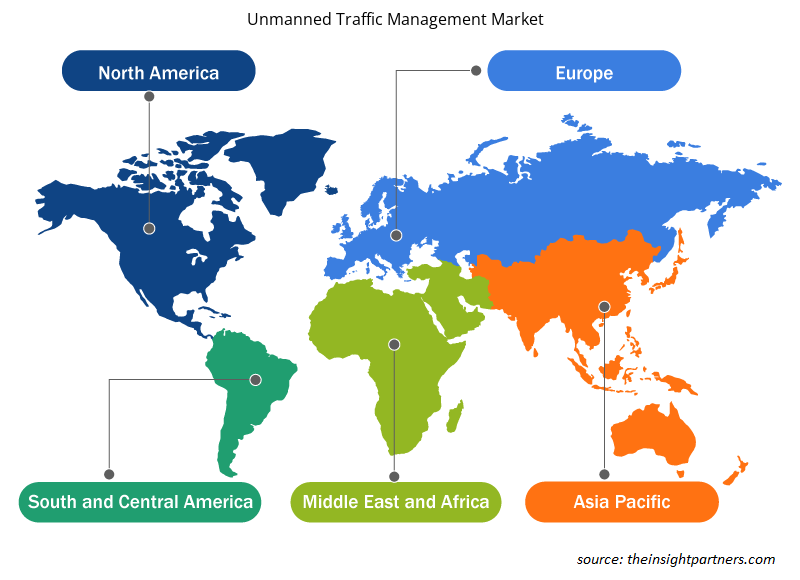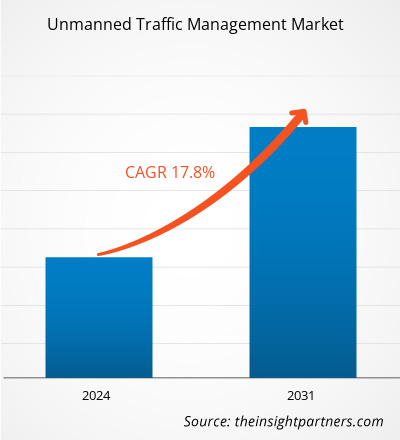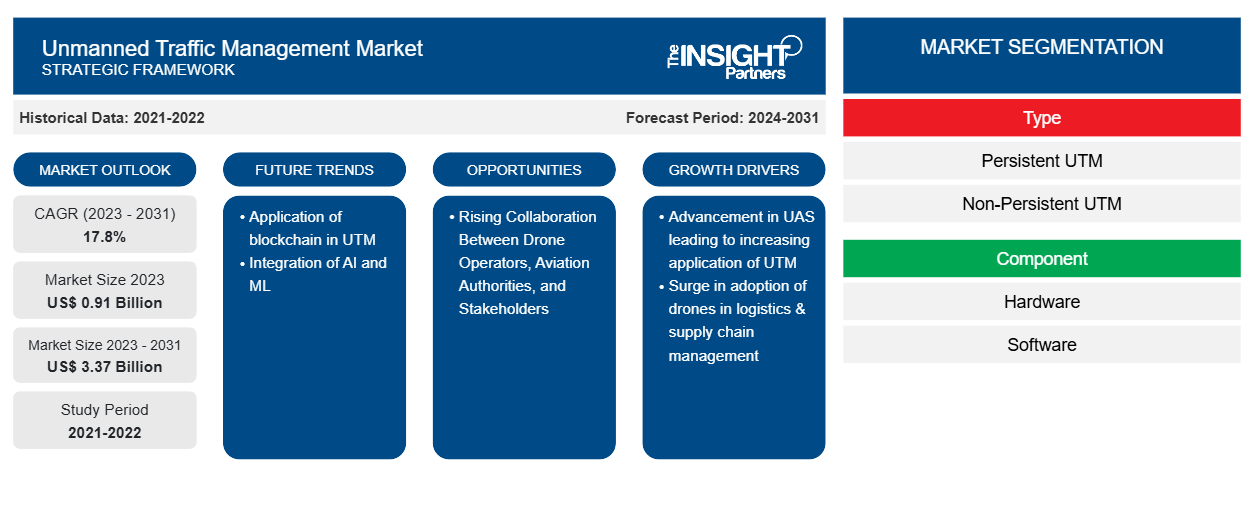Se prevé que el tamaño del mercado de gestión de tráfico no tripulado alcance los 3.370 millones de dólares en 2031, frente a los 910 millones de dólares en 2023. Se espera que el mercado registre una CAGR del 17,8 % durante el período 2023-2031. Es probable que la creciente aplicación de blockchain en UTM siga siendo una tendencia clave en el mercado.
Análisis del mercado de gestión del tráfico no tripulado
Las estrictas normas reglamentarias para la fabricación de productos de gestión del tráfico aéreo no tripulado son un reto crucial para los nuevos participantes. Las reglamentaciones obligatorias que cumplen las normas para controlar el tráfico aéreo han creado un desafío potencial para los nuevos participantes en el mercado. Por lo tanto, es una barrera de entrada para los nuevos participantes. Por lo tanto, un menor número de nuevos participantes permitiría a los actores existentes mantener una fuerte participación potencial en el mercado competitivo. Por lo tanto, estos factores hacen que la amenaza para los nuevos participantes sea baja o moderada.
Descripción general del mercado de gestión del tráfico no tripulado
Los principales actores en el ecosistema del mercado global de gestión de tráfico no tripulado incluyen fabricantes de hardware, desarrolladores de software, proveedores de sistemas UTM y usuarios finales. Los fabricantes de hardware son los fabricantes de sistemas que comprenden el desarrollo de varios componentes del sistema, como antenas, cámaras, sensores y otros. Con la creciente demanda de gestión de tráfico no tripulado para el creciente número de tráfico aéreo atribuido al aumento de las ventas de drones y UAS en todo el mundo, los fabricantes de UTM también están experimentando oportunidades de crecimiento sostenible. Luego, los desarrolladores de software diseñan software que ofrece la plataforma para recopilar y visualizar todos los datos para la toma de decisiones. Los fabricantes de sistemas UTM integran software y hardware en un solo sistema. Algunos de los principales proveedores de sistemas UTM son Lockheed Martin Corp; Thales SA; Frequentis AG; Airbus SE; y Raytheon Technologies Corp (Collins Aerospace Systems). Estos proveedores de UTM siempre están comprometidos con el avance de la gestión del tráfico no tripulado para su correcto funcionamiento. El principal uso final del mercado de gestión del tráfico no tripulado incluye operadores de vuelos militares y comerciales.
Personalice este informe según sus necesidades
Obtendrá personalización en cualquier informe, sin cargo, incluidas partes de este informe o análisis a nivel de país, paquete de datos de Excel, así como también grandes ofertas y descuentos para empresas emergentes y universidades.
-
Obtenga las principales tendencias clave del mercado de este informe.Esta muestra GRATUITA incluirá análisis de datos, desde tendencias del mercado hasta estimaciones y pronósticos.
Impulsores y oportunidades del mercado de gestión del tráfico no tripulado
Aumento de la adopción de drones en la logística y la gestión de la cadena de suministro
La gestión de la cadena de suministro (SCM) es un aspecto fundamental de la mayoría de las empresas y puede afectar directa o indirectamente al funcionamiento de las mismas. Con la creciente adopción de la Industria 4.0 y la creciente integración de dispositivos habilitados para Internet de las cosas (IoT) en todas las esferas empresariales, la SCM también está siendo testigo de una creciente integración de la tecnología. Si bien la adopción de tecnología tiene ramificaciones, los beneficios de dicha adopción superan en su mayoría los desafíos. Las ventajas incluyen una mayor eficiencia, un menor costo operativo y la seguridad de los datos. Con la creciente adopción de tecnología, las tecnologías UAV y UAS están ganando prominencia en la industria del transporte y la logística debido a los beneficios que ofrecen. Los drones se están utilizando en diferentes puntos de una cadena de suministro , como la gestión de inventario, el seguimiento de bienes "perdidos", la transferencia de bienes entre almacenes y la entrega de última milla. Las aplicaciones relativamente más nuevas de los drones incluyen colaboraciones de drones con camiones, conocidas como entrega paralela de múltiples UAV, en las que los drones ejecutan entregas a múltiples destinos directamente desde el camión de entrega. El desarrollo de vehículos aéreos no tripulados de carga, capaces de transportar grandes pesos a lo largo de varios cientos de kilómetros, promueve aún más la adopción de drones en esta industria. En julio de 2022, Amazon.com, Inc. anunció que planea entregar paquetes a sus clientes mediante drones en College Station, Texas, a fines de 2022. La compañía, en junio de 2022, anunció su plan de entregar algunos paquetes mediante drones en la ciudad de Lockeford, en el norte de California. Este desarrollo ha impulsado el crecimiento del mercado de gestión del tráfico no tripulado.
Creciente colaboración entre operadores de drones, autoridades de aviación y partes interesadas
Los operadores de drones han estado presionando para la adopción generalizada de aeronaves no tripuladas principalmente debido a las ventajas que ofrecen. Las autoridades de aviación , sin embargo, han sido cautelosas sobre cómo y dónde se operan estos vehículos. Las organizaciones e institutos de investigación han estado colaborando con ambas partes para desarrollar UTM. Una mejor colaboración entre las diversas partes interesadas de UTM puede garantizar aplicaciones comerciales más rápidas y seguras de drones y UAV. Con una mayor comprensión de esto, todas las partes interesadas han estado colaborando regularmente para armonizar las regulaciones y desarrollar un marco regulatorio para las operaciones de drones en VLOS y BVLOS.
Análisis de segmentación del informe de mercado de gestión de tráfico no tripulado
Los segmentos clave que contribuyeron a la derivación del análisis del mercado de gestión de tráfico no tripulado son tipo, componente, aplicación y usuario final.
- Según el tipo, el mercado de gestión del tráfico no tripulado se divide en UTM persistente y UTM no persistente. El segmento UTM persistente tuvo una mayor participación de mercado en 2023.
- Según los componentes, el mercado de gestión del tráfico no tripulado se divide en hardware y software. El segmento de hardware tuvo una mayor participación de mercado en 2023.
- Según la aplicación, el mercado de gestión del tráfico no tripulado se segmenta en comunicaciones, navegación, vigilancia y monitoreo, entre otros. El segmento de comunicaciones tuvo una mayor participación de mercado en 2023.
- Según el usuario final, el mercado de gestión del tráfico no tripulado se segmenta en agricultura y silvicultura, logística y transporte, vigilancia y otros. El segmento de defensa y aplicación de la ley tuvo una mayor participación de mercado en 2023.
Análisis de la cuota de mercado de la gestión del tráfico no tripulado por geografía
El alcance geográfico del informe del mercado de gestión de tráfico no tripulado se divide principalmente en cuatro regiones: América del Norte, Europa, Asia Pacífico y resto del mundo.
América del Norte ha dominado el mercado en 2023, seguida de las regiones de Europa y Asia Pacífico. Además, es probable que Asia Pacífico también sea testigo de la CAGR más alta en los próximos años. Estados Unidos dominó el mercado de gestión del tráfico no tripulado de América del Norte en 2023. Se espera que el mercado de gestión del tráfico no tripulado crezca en Estados Unidos debido a las regulaciones gubernamentales de apoyo mediante la promulgación de 11 tipos de legislación para el uso de drones en Florida, Idaho, Minnesota y Dakota del Sur, como permitir el uso de drones para trabajadores de gestión de emergencias, incluida la gestión de incendios forestales. Además, Idaho y Minnesota habían permitido a las agencias de aplicación de la ley operar sistemas de aeronaves no tripuladas (drones) para fines específicos, incluida la reconstrucción de accidentes de tráfico, misiones de búsqueda y rescate y fines de capacitación. Los estados de EE. UU. Habían formulado regulaciones para volar los drones para la mejora de la sociedad para diversas aplicaciones. Por lo tanto, se espera que las próximas regulaciones para los drones aumenten el número de vehículos no tripulados en el aire, lo que está aprovechando la demanda de sistemas de gestión del tráfico que impulsan el crecimiento del mercado. Además, las iniciativas de financiación gubernamentales de apoyo están contribuyendo aún más al crecimiento del mercado en el país. Por ejemplo, en marzo de 2021, la iniciativa Agility Prime de la Fuerza Aérea de los EE. UU. ayudará a financiar los esfuerzos de prueba de vuelo y certificación de alrededor de 20 aeronaves eVTOL diferentes que participan en su programa "Air Race to Certification". La iniciativa Agility Prime también está proporcionando financiación a 257 equipos de pequeñas empresas, universidades y otras instituciones de investigación sin fines de lucro que participan en trabajos de investigación y desarrollo (I+D) de eVTOL a corto plazo. Por lo tanto, estas iniciativas están acelerando la adopción de vehículos aéreos no tripulados, lo que impulsa el crecimiento del mercado.
Perspectivas regionales del mercado de gestión del tráfico no tripulado
Los analistas de Insight Partners explicaron en detalle las tendencias y los factores regionales que influyen en el mercado de gestión de tráfico no tripulado durante el período de pronóstico. Esta sección también analiza los segmentos y la geografía del mercado de gestión de tráfico no tripulado en América del Norte, Europa, Asia Pacífico, Oriente Medio y África, y América del Sur y Central.

- Obtenga datos regionales específicos para el mercado de gestión de tráfico no tripulado
Alcance del informe sobre el mercado de gestión del tráfico no tripulado
| Atributo del informe | Detalles |
|---|---|
| Tamaño del mercado en 2023 | 0,91 mil millones de dólares estadounidenses |
| Tamaño del mercado en 2031 | US$ 3.37 mil millones |
| CAGR global (2023 - 2031) | 17,8% |
| Datos históricos | 2021-2022 |
| Período de pronóstico | 2024-2031 |
| Segmentos cubiertos |
Por tipo
|
| Regiones y países cubiertos |
América del norte
|
| Líderes del mercado y perfiles de empresas clave |
|
Densidad de actores del mercado de gestión del tráfico no tripulado: comprensión de su impacto en la dinámica empresarial
El mercado de gestión de tráfico no tripulado está creciendo rápidamente, impulsado por la creciente demanda de los usuarios finales debido a factores como la evolución de las preferencias de los consumidores, los avances tecnológicos y una mayor conciencia de los beneficios del producto. A medida que aumenta la demanda, las empresas amplían sus ofertas, innovan para satisfacer las necesidades de los consumidores y aprovechan las tendencias emergentes, lo que impulsa aún más el crecimiento del mercado.
La densidad de actores del mercado se refiere a la distribución de las empresas o firmas que operan dentro de un mercado o industria en particular. Indica cuántos competidores (actores del mercado) están presentes en un espacio de mercado determinado en relación con su tamaño o valor total de mercado.
Las principales empresas que operan en el mercado de gestión de tráfico no tripulado son:
- Corporación Lockheed Martin
- Leonardo SpA
- Grupo Thales
- Corporación Raytheon Technologies
- Altitud Angel Ltd
- Frequentis AG
Descargo de responsabilidad : Las empresas enumeradas anteriormente no están clasificadas en ningún orden particular.

- Obtenga una descripción general de los principales actores clave del mercado de gestión de tráfico no tripulado
Noticias y desarrollos recientes del mercado de gestión de tráfico no tripulado
El mercado de gestión de tráfico no tripulado se evalúa mediante la recopilación de datos cualitativos y cuantitativos posteriores a la investigación primaria y secundaria, que incluye publicaciones corporativas importantes, datos de asociaciones y bases de datos. A continuación, se enumeran algunos de los avances en el mercado de gestión de tráfico no tripulado:
- Thales y Thaicom, a través de la filial de Thaicom, un operador de satélites asiático líder y proveedor de comunicaciones satelitales integradas, establecen las bases de un marco de gestión de tráfico no tripulado (UTM) para permitir el crecimiento del ecosistema de drones en Tailandia. (Fuente: Thales, comunicado de prensa, abril de 2024)
- CAL Analytics, en coordinación con el Departamento de Transporte de Ohio (ODOT), ha lanzado un sistema de gestión del tráfico aéreo a baja altitud para drones con el fin de respaldar las operaciones en todo el estado. (Fuente: CAL Analytics, comunicado de prensa, marzo de 2024)
Informe sobre el mercado de gestión del tráfico no tripulado: cobertura y resultados
El informe “Tamaño y pronóstico del mercado de gestión del tráfico no tripulado (2021-2031)” proporciona un análisis detallado del mercado que cubre las siguientes áreas:
- Tamaño del mercado de gestión de tráfico no tripulado y pronóstico a nivel mundial, regional y nacional para todos los segmentos clave del mercado cubiertos bajo el alcance
- Tendencias del mercado de gestión del tráfico no tripulado, así como dinámica del mercado, como impulsores, restricciones y oportunidades clave
- Análisis detallado de las cinco fuerzas de Porter
- Análisis del mercado de gestión del tráfico no tripulado que abarca las tendencias clave del mercado, el marco global y regional, los principales actores, las regulaciones y los desarrollos recientes del mercado
- Análisis del panorama de la industria y de la competencia que abarca la concentración del mercado, el análisis de mapas de calor, los actores destacados y los desarrollos recientes del mercado de gestión del tráfico no tripulado
- Perfiles detallados de empresas
- Análisis histórico (2 años), año base, pronóstico (7 años) con CAGR
- Análisis PEST y FODA
- Tamaño del mercado, valor/volumen: global, regional y nacional
- Industria y panorama competitivo
- Conjunto de datos de Excel
Informes recientes
Informes relacionados
Testimonios
Razón para comprar
- Toma de decisiones informada
- Comprensión de la dinámica del mercado
- Análisis competitivo
- Información sobre clientes
- Pronósticos del mercado
- Mitigación de riesgos
- Planificación estratégica
- Justificación de la inversión
- Identificación de mercados emergentes
- Mejora de las estrategias de marketing
- Impulso de la eficiencia operativa
- Alineación con las tendencias regulatorias























 Obtenga una muestra gratuita para - Mercado de gestión del tráfico no tripulado
Obtenga una muestra gratuita para - Mercado de gestión del tráfico no tripulado